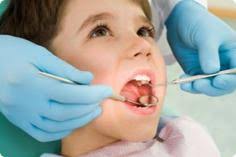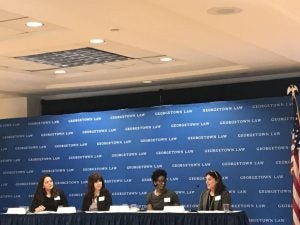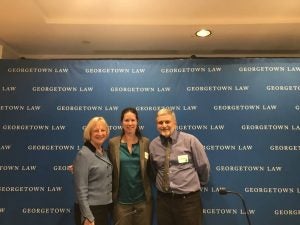
A few weeks ago I posted a blog about Deamonte Driver, a twelve year old boy who died of a toothache in Maryland in February 2007. It is hard to believe a child can die in the United States from an untreated cavity, especially so close to the nation’s capital. While Deamonte’s death sparked outrage and change in Maryland, much still needs to be done in the District, especially for children with special health care needs.
Americans face barriers to accessing dental health care. This is especially true for those that are uninsured, low-income families, communities of color, and people with disabilities. Over 48 million people live in areas in the United States with dentist shortages. While 72 million children and adults rely on Medicaid and the Children’s Health Insurance Program (CHIP), only about one-third of dentists accept public insurance.
Last week with generous support from the George E. Richmond Foundation, Georgetown University’s Health Justice Alliance, the O’Neill Institute, and the Harrison Institute for Public Law hosted a convening focusing on barriers to accessing oral health care for children with special health care needs in Washington, DC. The event gathered professionals and scholars working in health care and oral health to bring awareness to the lack of access to oral health care for children with special health care needs, particularly those from low-income areas in Washington, DC.
The convening served two purposes: (1) to draw attention to the fact that there are a number of barriers to accessing oral health care for children with special health care needs in Washington, DC; and (2) to identify possible solutions to these barriers.

One of the highlights of the day was the morning panel, which set the stage for the day and consisted of two parents of children with special health care needs—Jana Monaca and Eva Scheer—and Dr. Grant-Anamelechi, a practicing dentist. The panelists shared their personal experiences and identified some of the barriers to accessing oral health care in the Washington, DC area.
Jana Monaco is an advocate and a mother of four, two of which have a rare inborn metabolism called Isovaleric Acidemia. Her son, Stephen, 20, suffered severe brain damage at the age of 3 ½ leaving him with severe disabilities and complex medical issues due to a lack of comprehensive newborn screening at birth. Eva Scheer, has two sons. Her son Cade, 17, has autism and attends high school in Montgomery Country’s autism program.
These women shared powerful stories of how they advocate for their children and the importance of oral health for the overall well-being of their children. They shared anecdotes of both good and bad experiences taking their sons to the dentist. Going to the dentist can be a scary experience for any child, but this is especially true for children with physical and/or mental disabilities. One particular example Eva shared is that the use of a weighted blanked really helped her son Cade feel safer and more secure at the dentist. They shared how noises can be very distracting and scary for children with disabilities, especially at the dentist.
Dr. Grant-Anamelechi is the owner of Children’s Choice Pediatric Dentistry and Orthodontics in New Carrollton, MD. She practiced for a number of years prior to opening her own practice. Dr. Grant was recently named one of America’s Top Pediatric Dentists by Consumers’ Research Council of America. Her patients range in age from five days old to twenty-six years old. Dr. Grant has an acute awareness of her patients’ needs, and this extends to her patients with special health care needs. During the panel she shared some of the tools she has implemented at her practice to ensure a safe and enjoyable dental experience for children with special needs and their parents. This starts from scheduling the appointment, where her staff asks about special accommodations or requests that will help make her patients feel more comfortable. Dr. Grant spoke to the importance of being aware of when a child enjoys stimulation versus when a child does not. For some of her patients that are bothered by noises, she implements a quiet time right before the child arrives for his or her appointment that lasts until the patient leaves. This includes shutting off the television or any music that may be playing in the waiting room or dental suite. Another tool Dr. Grant has found useful is creating a PowerPoint presentation for her patients with photos of her staff and the office so her patients can become familiar with the people and the environment prior to their dental visit. For many of her patients, this helps ease tension and anxiety about going to the dentist.
The morning panel was followed by breakout sessions where participants had opportunities to delve deeper into five main barriers related to accessing oral health care. The five breakout session topics were: (1) transportation, (2) case management oversight, (3) financial incentives, (4) scope of practice, and (5) school-based health centers.
Following the breakout sessions was the afternoon panel titled Where to Go from Here: Improving Oral Health in the District and Beyond, which included two dentists and public health experts, Dr. Joan I. Gluch (UPenn Dental) and Dr. Jay Balzer (Dental Public Health, NYU Langone Hospital and Medical School in New York) who discussed their experiences working in oral health in their cities. They recommended policy solutions that have been utilized in their respective communities including engaging both the private and public spheres and universities to help ensure access to oral health services for children with special health needs. Dr. Gluch shared her experiences of integrating a mobile oralhealth unit as well as training health care workers to provide certain oral health treatments which helped increase access to oral health care and cut costs in Philadelphia. Dr. Balzer emphasized the importance of bringing oral health facilities to the people that need them the most, rather than forcing patients to find their way to dentists themselves, which is burdensome for low-income individuals and people with disabilities.

The day ended on an optimistic note with promises of continuing this important conversation long after the convening. The participants were highly engaged in the day’s events and the organizers hope to build on this momentum to make positive policy changes to ensure improved access to oral health care for children with special health care needs in the District and beyond.



